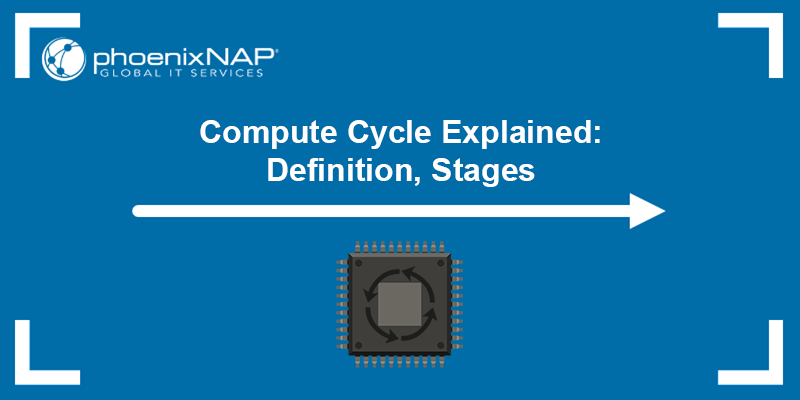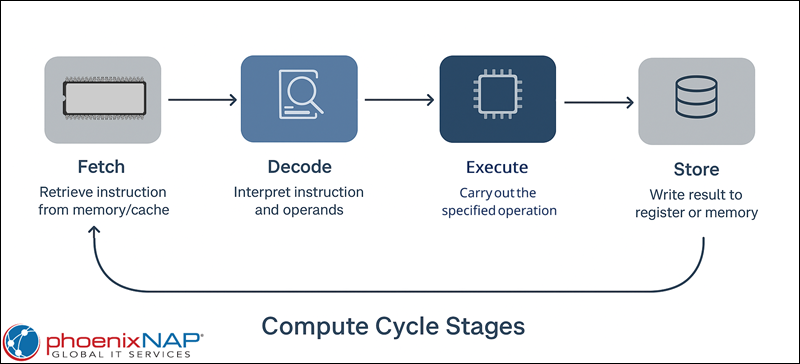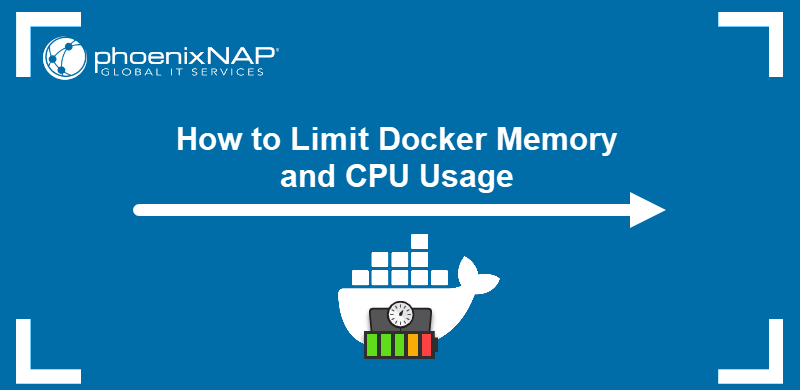Compute cycles are a key metric for understanding how computers and cloud applications perform tasks and handle workloads. Knowing what affects compute cycles, how to calculate them, and how providers track usage can help you optimize performance and manage costs effectively.
This article explains the compute cycle concept, covers its role in CPU instruction execution and its use as a cloud hosting metric, and shows how to calculate it.

What Is a Compute Cycle?
In cloud hosting, a compute cycle (CC) measures the amount of processing time an application uses to handle requests and deliver content. Some providers use compute cycles as a billing unit to charge customers based on how much server processing their sites or applications consume. In this sense, compute cycles represent real CPU time allocated to your workload in a shared environment.
The term comes from computer architecture, where a compute cycle (also called a computation cycle or machine cycle) refers to the steps a CPU takes to execute an instruction. These steps commonly include four stages:
1. Fetch. The CPU retrieves the instruction from memory or cache.
2. Decode. The instruction's opcode and operands are interpreted to determine what action is required.
3. Execute. The CPU performs the operation, such as an arithmetic calculation or logical comparison.
4. Store (Write Back). Writing the result to a register, memory, or cache, making it available for subsequent instructions.

While in hardware, a compute cycle may span one or several CPU clock ticks. In cloud environments, the idea becomes a measurable unit of processing power. Understanding these stages helps explain why some instructions take more cycles than others and why CPU design affects overall performance.
What Affects Compute Cycle Time?
There are several factors that influence how long a compute cycle takes and how many cycles an application consumes. Some key factors include:
- CPU architecture and clock speed. The processor design and its operating frequency determine how fast each instruction cycle can be completed.
- Instruction complexity. Simple instructions may finish in a single cycle, while more complex ones (like division or floating-point operations) require multiple cycles.
- Parallelism and pipelining. Modern CPUs overlap tasks and use multiple execution units, reducing the effective cycle time and allowing more instructions per cycle.
- Application workload. Heavier workloads, such as database queries or intensive data processing, consume more cycles than lightweight operations.
- Code efficiency and optimization. Well-optimized code executes with fewer instructions, while inefficient code wastes compute cycles on unnecessary operations.
- Cloud resource allocation. In shared hosting or cloud platforms, providers may limit how much CPU time is available per customer, directly affecting cycle usage.
From a hardware perspective, compute cycle time depends on the CPU's design and performance. Faster clock speeds shorten cycle duration, but the number of cycles per instruction varies by instruction type and processor efficiency. Features like pipelining and multiple arithmetic units allow modern CPUs to execute more work in fewer cycles.
In a cloud environment, cycle consumption is tied more closely to workload and resource allocation. Applications that perform heavy computations, handle large traffic volumes, or run inefficient code will use more compute cycles. Providers may also enforce limits or prioritize resources, which means that two applications on the same hardware can have different compute cycle usage patterns.
How to Calculate Compute Cycle Time
The way compute cycle time is calculated depends on whether you are looking at raw CPU performance or cloud usage metrics.
On the hardware side, cycle time can be expressed with the following factors:
- Clock speed. The duration of a single clock cycle is the inverse of the processor frequency. For example, a 2 GHz CPU has a clock cycle of 0.5 nanoseconds at a steady 2 GHz frequency.
- Cycles per instruction (CPI). Not all instructions complete in one cycle. Complex operations may require multiple cycles, which increases the average CPI.
- Instruction count. The total number of instructions in a program determines how many cycles are needed overall.
The relationship is commonly summarized as:
Execution time = Instruction count × CPI × Clock cycle timeIn cloud hosting, the concept becomes a billing unit. Providers do not expect users to track instruction counts or CPI. Instead, they measure the following:
- Total CPU time used. How much time the server spent processing your application's requests.
- Normalized compute cycles. Each provider defines what one compute cycle represents (e.g., a fixed slice of CPU time).
- Usage reporting. The hosting platform tracks your site or app's compute cycle consumption and charges accordingly.
The CPU usage is converted into compute cycles based on the provider's internal definition of what one cycle equals. The result is a practical metric that reflects the resources your application used and determines the corresponding cost.
Cloud Compute Cycles
In cloud hosting, compute cycles are a billing and resource management unit. They translate raw CPU processing into an understandable measure of how much work your application consumes.
Note: Many providers no longer use compute cycles as a billing unit. They generally use vCPUs, CPU credits, or hourly-based pricing (such as phoenixNAP BMC).
Key aspects of cloud compute cycles include:
- Definition by provider. Each hosting company defines what one compute cycle represents. For example, it may equal a fixed slice of CPU time (such as 1/1000th of a second on a single core).
- Workload impact. Sites or applications with high traffic, heavy scripts, or complex database queries use more compute cycles than lightweight, static sites.
- Resource limits. Providers may cap the number of compute cycles per plan, restricting how much CPU power you can consume before needing an upgrade.
- Billing transparency. Usage is in cycles, making it easier to see how your consumption translates into costs.
- Optimization opportunities. Reducing inefficient code, caching content, and optimizing database queries lowers compute cycle consumption and, therefore, hosting costs.
This system allows providers to fairly distribute shared resources while giving customers a clear understanding of their application's demand on the server.
Conclusion
This article explained compute cycles and how they offer insight into low-level CPU operations and cloud application performance. By understanding the factors that influence cycle time, applying proper calculation methods, and monitoring usage in hosting environments, you can improve efficiency, reduce resource consumption, and make informed decisions about infrastructure.
Next, learn about bare metal cloud, or check out our list of the best 14 cloud cost management tools.

